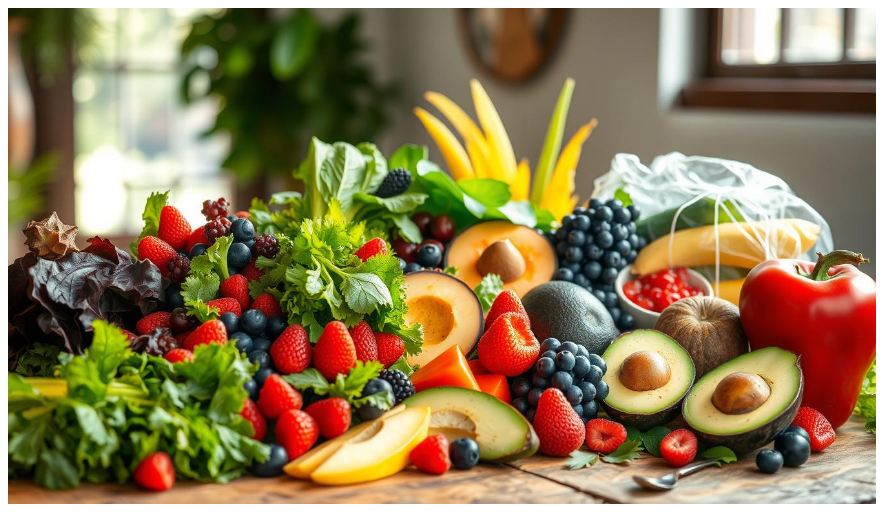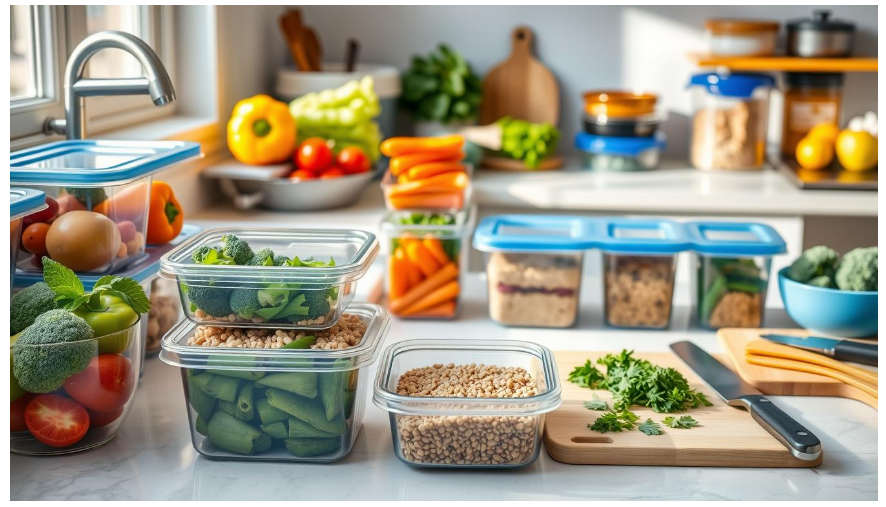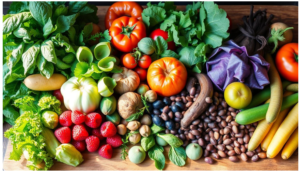Healthy Eating: What if the secret to a long, healthy life was just changing your eating habits? Eating well is key to staying healthy and feeling great. A balanced diet gives your body what it needs to work right and keeps you safe from big diseases. With most adults eating too many calories, it’s vital to know why eating healthy matters.
Healthy eating isn’t just about avoiding bad foods. It’s also about eating the right amount of calories for your activity level. A good diet includes lots of fruits, veggies, whole grains, lean proteins, and healthy fats. By choosing the right foods, you can lower your risk of serious diseases and boost your health and happiness.
Key Takeaways
- Eating a healthy, balanced diet is essential for maintaining good health and preventing chronic diseases.
- A balanced diet should include a variety of foods from all food groups, including fruits, vegetables, whole grains, lean proteins, and healthy fats.
- Healthy eating can help reduce the risk of chronic diseases, such as heart disease, type 2 diabetes, and certain cancers.
- Understanding nutrition and making informed food choices is crucial for a balanced diet and overall health benefits.
- By making a few adjustments to your daily eating habits, you can improve your overall health and well-being through healthy eating and a balanced diet.
- Staying hydrated by drinking 6 to 8 glasses of non-alcoholic beverages per day is also important for a healthy and balanced diet.

Understanding the Basics of Healthy Eating
Healthy eating means choosing foods that give your body what it needs. A good meal planning plan helps you eat well. It’s all about eating whole foods like fruits, veggies, whole grains, and lean proteins.
Choosing clean eating means avoiding foods full of added sugars, fats, and salt. Instead, eat foods rich in nutrients like leafy greens, berries, and fatty fish.
What Constitutes a Balanced Diet
A balanced diet gives your body what it needs to function well. It includes foods from all groups: fruits, veggies, whole grains, lean proteins, and healthy fats. Focus on whole foods and cut down on processed foods.
The Role of Macronutrients
Macronutrients like carbs, proteins, and fats are key for energy and health. A good diet has a mix of these from whole foods.
Essential Micronutrients for Optimal Health
Micronutrients like vitamins and minerals are vital for health. A clean eating diet helps you get enough of these. Important ones include vitamin C, calcium, and iron.
| Food Group | Recommended Daily Intake |
|---|---|
| Fruits | 2-3 servings |
| Vegetables | 3-5 servings |
| Whole Grains | 3-5 servings |
| Lean Proteins | 2-3 servings |
By planning meals with whole foods and clean eating, you get the nutrients you need. This means eating a variety of nutrient-dense foods like fruits, veggies, whole grains, and lean proteins.
The Power of Whole Foods in Your Diet
Whole foods like fruits, veggies, whole grains, and lean proteins have been key to a healthy diet for ages. These natural foods give us vital nutrients, fiber, and help us feel full. They are essential for a balanced diet.
Eating a diet full of whole foods helps keep us healthy and happy. It helps us stay at a healthy weight and lowers the risk of serious diseases.
Adding organic food to your meals can make your diet even better. Organic foods have more antioxidants and fewer pesticides. This makes them a great choice for a healthier lifestyle.
Choosing whole, nutrient-dense foods can boost your energy, improve digestion, and lower disease risks.
- Improved energy levels and mental clarity
- Support for healthy weight management
- Reduced risk of chronic diseases, such as heart disease and diabetes
- Improved digestion and gut health
By adopting amindful eatingapproach and focusing on whole,nutrient-densefoods, you can start a journey to a healthier, more balanced diet.
Building a Nutrient-Dense Plate
To create a balanced diet, focus on nutrient-dense foods. This includes vitamin-rich foods and whole grains. A good meal prep plan helps you achieve this goal.
When building your plate, aim for 50% vegetables and fruits, 25% whole grains, and 25% healthy proteins. Color diversity in meals is key. It ensures you get a wide range of vitamins and minerals.
Dark leafy greens like spinach and kale are rich in iron and calcium. Bell peppers are high in vitamin C. Choosing seasonal and locally sourced produce supports sustainable nutrition and the environment.
Portion Control Guidelines
Portion control is vital for a healthy diet. Using smaller plates and bowls helps you eat less. Drinking water between bites slows down eating and promotes fullness.
Eating meals at a table, not in front of a screen, improves portion awareness. This helps you stay on track with your diet.
Color Diversity in Meals
Color diversity on your plate ensures a range of nutrients. Include dark leafy greens, vibrant fruits, and whole grains in your meals. This approach supports a balanced and sustainable nutrition plan.
Balancing Food Groups
Balancing your food groups is key to a healthy diet. Include a mix of protein sources, whole grains, and fruits and vegetables. Focus on nutrient-dense foods and sustainable nutrition for a meal prep plan that supports your health.
Smart Meal Planning Strategies
Meal planning is key to healthy eating. It saves time, money, and ensures you get all the nutrients you need. By planning ahead, you can make healthy recipes that fit your diet and taste. It also helps you shop smarter, cutting down on waste and saving money.
Meal planning has many benefits. It reduces stress at mealtime, boosts veggie intake, and cuts down on impulse buys. In fact, up to 50% of people feel less stressed about meals when they plan. It also helps you learn nutrition tips like portion control and balanced eating.
Here are some tips for effective meal planning:
- Plan meals around seasonal produce to save money and ensure freshness
- Keep a running grocery list to reduce impulse purchases
- Rotate 3 to 5 meal options each week to reduce grocery costs
By using these strategies, you can create a meal planning routine that suits you. It helps you reach your health and wellness goals. With a bit of planning and creativity, you can make tasty, nutritious meals that are budget-friendly.
Understanding Clean Eating Principles
Clean eating means eating whole, unprocessed foods like fruits, veggies, and whole grains. It’s about choosing a plant-based diet full of nutritious recipes and avoiding processed stuff. By picking organic food, you cut down on pesticides and harmful substances.
Key clean eating tips include reading labels, avoiding processed foods, and opting for organic. Here’s how to begin:
- Read food labels to spot added sugars, artificial preservatives, and other bad stuff.
- Stay away from processed foods like packaged snacks and frozen meals. They’re loaded with unhealthy fats, sugars, and sodium.
- Pick organic fruits, veggies, and whole grains. They’re grown without synthetic pesticides and fertilizers.
Embracing clean eating can boost your heart health, brain function, and help with weight. A plant-based diet full of nutritious recipes can also lower disease risks like diabetes and some cancers.
Adding clean eating to your life is easy and tasty. Start by trying new organic food and making nutritious recipes with whole ingredients. With some effort, you’ll build a healthy food relationship that feeds your body and soul.
The Benefits of Plant-Based Nutrition
A well-planned plant-based diet can help lower the risk of many diseases. This includes heart disease, type 2 diabetes, and some cancers. By adding nutritious recipes to your meals, you make sure you get all the nutrients you need.
Key nutrition tips for a plant-based diet include eating lots of fruits, vegetables, whole grains, and legumes. Don’t forget to add healthy fats like nuts and seeds to your meals. Here are some nutrient-rich plant-based foods:
- Leafy greens, such as kale and spinach
- Cruciferous vegetables, such as broccoli and cauliflower
- Legumes, such as lentils and chickpeas
- Nuts and seeds, such as almonds and chia seeds
By following these nutrition tips and eating a variety of plant-based foods, you can lower your disease risk. A plant-based diet is a healthy choice that makes you feel great. With a bit of planning, you can get all the nutrients you need.

| Food Group | Examples | Nutritional Benefits |
|---|---|---|
| Fruits | Apples, bananas, berries | Rich in vitamins, minerals, and antioxidants |
| Vegetables | Broccoli, carrots, spinach | High in fiber, vitamins, and minerals |
| Whole Grains | Brown rice, quinoa, whole wheat bread | Rich in fiber, vitamins, and minerals |
Mindful Eating Practices for Better Health
Mindful eating focuses on being fully present when we eat. It’s about noticing the taste, texture, and smell of our food. It also means paying attention to when we’re hungry and when we’re full. This approach helps us have a healthier relationship with food and our bodies.
Key mindful eating practices include eating without distractions and recognizing hunger cues. It’s also important to be aware of how much we’re eating. For instance, eating slowly and enjoying each bite can make us feel more satisfied. This can help us avoid unhealthy snacks or eating too much.
Adding healthy recipes to our diet supports mindful eating. Recipes filled with whole foods like fruits, vegetables, and grains give us the nutrients we need. Combining mindful eating with healthy recipes helps us nourish our bodies and minds.
- Improved weight management
- Increased satisfaction with food
- Reduced stress and anxiety related to eating
- Improved digestion and reduced symptoms of digestive disorders
By making mindful eating a part of our daily lives, we can improve our relationship with food and our bodies. This leads to better health and well-being overall.
| Benefits of Mindful Eating | Description |
|---|---|
| Improved weight management | Reduced overeating and increased satisfaction with food |
| Increased satisfaction with food | Greater enjoyment of food and reduced cravings for unhealthy snacks |
| Reduced stress and anxiety related to eating | Improved emotional well-being and reduced stress related to food choices |
Sustainable Approaches to Weight Management
Managing weight requires focusing on long-term health. This means eating well and staying active. Healthy recipes are key, giving the body what it needs to function well.
Setting realistic goals is important. Aim to lose 1 to 2 pounds a week. Regular exercise, like cardio and strength training, is also crucial. Adopting sustainable eating habits is vital, making small changes each day.
Regularly checking your weight helps track progress. Always talk to a healthcare provider before starting any diet. Sustainable weight management leads to better heart health and lowers disease risk.
- Eating a variety of whole foods, such as fruits, vegetables, and whole grains
- Incorporating healthy recipes into meal plans, such as the Mediterranean diet
- Reducing calorie intake and increasing physical activity levels
- Seeking support from healthcare providers or weight loss groups
By focusing on sustainable weight management, you can achieve lasting success. This includes healthy recipes, regular exercise, and professional advice. With the right approach, you can reach your weight goals and live a healthy life.
| Strategy | Benefits |
|---|---|
| Sustainable eating habits | Improved heart health, reduced risk of chronic diseases |
| Regular physical activity | Weight loss, improved mental health, increased energy levels |
| Professional guidance | Personalized support, increased motivation, improved outcomes |
Meal Prep Tips for Busy Lives
Busy lives often lead to quick takeout meals, which can be high in calories. Meal prep saves time and money, helping control weight and eat better. Planning meals before grocery shopping makes eating affordable.
Setting aside specific days for meal planning and cooking is key. This keeps things organized and ensures healthy meals are always ready. For example, dedicating 1 hour a week to meal prep can save time and stress.
Some healthy recipes can be made ahead and stored for later. Cooked ground meats last 1-2 days, while whole meats and fish last 3-4 days. Knowing this helps make better meal prep choices.
Using meal prep calendars helps plan meals around your schedule. This reduces waste and saves money. By making meal prep a weekly habit, you can eat more veggies and follow a balanced diet.

Incorporating Superfoods into Your Diet
Superfoods are packed with nutrients and offer many health benefits. They include leafy greens, berries, and nuts. To get the most from dark berries like blueberries, strawberries, and raspberries, eat half a cup four times a week.
Adding superfoods to your meals is simple and tasty. Mix spinach or kale into your nutritious recipes for extra vitamins and minerals. Snack on unsalted pistachios for antioxidants and fiber. Drinking 12 to 16 ounces of green or white tea daily can help fight cancer and heart disease.
Here are some examples of superfoods and their benefits:
- Quinoa: high in protein and contains all nine essential amino acids
- Blueberries: high in antioxidants, promoting heart health and bone strength
- Kale: high in vitamin K, vital for bone health and reducing the risk of blood clotting
Adding a variety of superfoods to your diet boosts your nutrient intake. Choose whole foods for the best nutrition. Get creative with your nutritious recipes. Follow these nutrition tips to enjoy superfoods’ benefits today.
| Superfood | Benefits |
|---|---|
| Leafy Greens | Rich in vitamins and minerals |
| Berries | High in antioxidants and flavonoids |
| Nuts | Rich in healthy fats and protein |
Common Nutrition Myths Debunked
When it comes to healthy eating, many nutrition myths can confuse us. It’s key to know the truth and follow nutrition tips that are scientifically proven. For example, not all low-fat or fat-free foods are good for us. Often, they are filled with added sugars or artificial stuff.
Instead, choose whole, unprocessed foods like fruits, veggies, whole grains, lean proteins, and healthy fats. The Dietary Guidelines suggest eating at least 50% whole grains. Also, adults should have 3 servings a day of fat-free or low-fat dairy.Healthy Eating:
Another myth is that all fats are bad. But, fats like those in nuts, seeds, and avocados are good for us. By sticking to these nutrition tips and avoiding nutrition myths, we can make better food choices. This helps us stay healthy through healthy eating habits.
| Food Group | Recommended Daily Intake |
|---|---|
| Fruits | 1.5-2 cups |
| Vegetables | 2.5-3 cups |
| Whole Grains | 3-5 ounces |
| Lean Proteins | 5-5.5 ounces |
Conclusion: Making Healthy Eating a Lifestyle
Healthy eating is not just a quick fix. It’s a lifelong journey to better nutrition and a balanced diet. By using the tips from this article, you can change how you see food. This leads to amazing health benefits from making smart food choices.
Starting small can lead to big changes. Try meal planning, eating more whole foods, and watching your portion sizes. Also, learn about plant-based diets, superfoods, and debunk nutrition myths. These steps help you make choices that boost your health.
The journey to a healthier you starts with every meal. By making healthy eating a lifestyle, you nourish your body and appreciate the power of good nutrition. Start this journey with determination. Let the benefits of better health and well-being lead you to a more fulfilling life.
FAQ
What is a balanced diet?
A balanced diet includes a variety of foods. This includes whole grains, fruits, vegetables, lean proteins, and healthy fats. It gives the body the right mix of nutrients.Healthy Eating:
Why is it important to eat a wide range of whole foods?
Eating a variety of whole foods is key. It ensures you get all the nutrients your body needs. Whole foods are also less processed, which means they have fewer added sugars, fats, and sodium.
What are the benefits of incorporating organic foods into a healthy diet?
Organic foods are grown without harmful chemicals. They often have more nutrients and fewer chemicals. Choosing organic supports sustainable farming and is better for the environment.
How can I build a nutrient-dense plate?
To build a nutrient-dense plate, focus on colorful fruits and vegetables. Add whole grains, lean proteins, and healthy fats. Aim for a balance and choose a variety of foods to get all the nutrients.
What are the benefits of meal planning and prep?
Meal planning and prep save time and reduce waste. They help you have healthy meals ready. It’s a way to make better choices and control portions.
What are the principles of clean eating?
Clean eating focuses on whole, minimally processed foods. It means reading labels to avoid unhealthy ingredients. It’s a diet rich in fruits, vegetables, and lean proteins.
What are the benefits of a plant-based diet?
A plant-based diet reduces chronic disease risk. It’s good for heart health, weight management, and gut health. It also helps the environment.
How can I practice mindful eating?
Mindful eating means eating with full attention. Pay attention to hunger and fullness cues. It helps you eat better and manage weight.
What are some tips for sustainable weight management?
Sustainable weight management is about gradual, healthy changes. Eat a balanced diet, exercise regularly, and get enough sleep. Avoid crash diets.
What are the benefits of incorporating superfoods into my diet?
Superfoods are packed with nutrients. They improve immune function, heart health, and reduce inflammation. Adding them to your diet can be very beneficial.
What are some common nutrition myths?
Some myths say all fats are bad and carbs should be avoided. Others claim quick fixes for weight loss or health issues. Always rely on science and consult experts for diet advice.
Source Links
- https://www.nhs.uk/live-well/eat-well/how-to-eat-a-balanced-diet/eight-tips-for-healthy-eating/
- https://www.cdc.gov/nccdphp/dnpao/features/healthy-eating-tips/index.html
- https://www.heartandstroke.ca/healthy-living/healthy-eating/healthy-eating-basics
- https://www.healthline.com/nutrition/how-to-eat-healthy-guide
- https://www.bgnaturalhealth.com/articles/the-power-of-whole-food-eating
- https://pmc.ncbi.nlm.nih.gov/articles/PMC9189583/
- https://nutritionsource.hsph.harvard.edu/healthy-eating-plate/
- https://selecthealth.org/blog/2016/02/building-a-healthy-plate
- https://www.heart.org/en/healthy-living/healthy-eating/eat-smart/nutrition-basics/how-can-i-eat-more-nutrient-dense-foods
- https://www.mayoclinic.org/healthy-lifestyle/nutrition-and-healthy-eating/in-depth/healthy-meals/art-20546806
- https://www.eatright.org/food/planning/smart-shopping/3-strategies-for-successful-meal-planning
- https://nutritionsource.hsph.harvard.edu/clean-eating/
- https://pedersonsfarms.com/blogs/blog/pederson-s-ultimate-guide-to-clean-eating?srsltid=AfmBOorVy9DyGVJqhzfcaXycD6iUBbWq620ONdpaqZl8zHQAw2YYCv2W
- https://zoe.com/learn/clean-eating
- https://lifestylemedicine.org/articles/benefits-plant-based-nutrition/
- https://www.heart.org/en/healthy-living/healthy-eating/eat-smart/nutrition-basics/how-does-plant-forward-eating-benefit-your-health
- https://nutritionsource.hsph.harvard.edu/mindful-eating/
- https://health.clevelandclinic.org/mindful-eating
- https://www.healthhero.ie/blog/comprehensive-guide-to-safe-and-sustainable-weight-loss
- https://www.bhf.org.uk/informationsupport/heart-matters-magazine/nutrition/weight/steps-to-sustainable-weight-loss
- https://www.ncbi.nlm.nih.gov/books/NBK221839/
- https://nutritionsource.hsph.harvard.edu/meal-prep/
- https://thegirlonbloor.com/meal-prep-busy-people/
- https://www.leighmerotto.com/blog/meal-prep-and-planning-for-busy-people
- https://www.piedmont.org/living-real-change/14-superfoods-to-add-to-your-diet
- https://beyondjuiceryeatery.com/nutrition-education/the-science-behind-superfoods-why-you-should-add-them-to-your-diet/
- https://www.niddk.nih.gov/health-information/weight-management/myths-nutrition-physical-activity
- https://www.scripps.org/news_items/4436-9-common-food-myths-debunked
- https://www.medicalnewstoday.com/articles/322268
- https://www.outreachhealth.com/2022/01/healthy-food-choice-for-a-healthy-lifestyle/
Click here to learn more about this topic in a related article.





